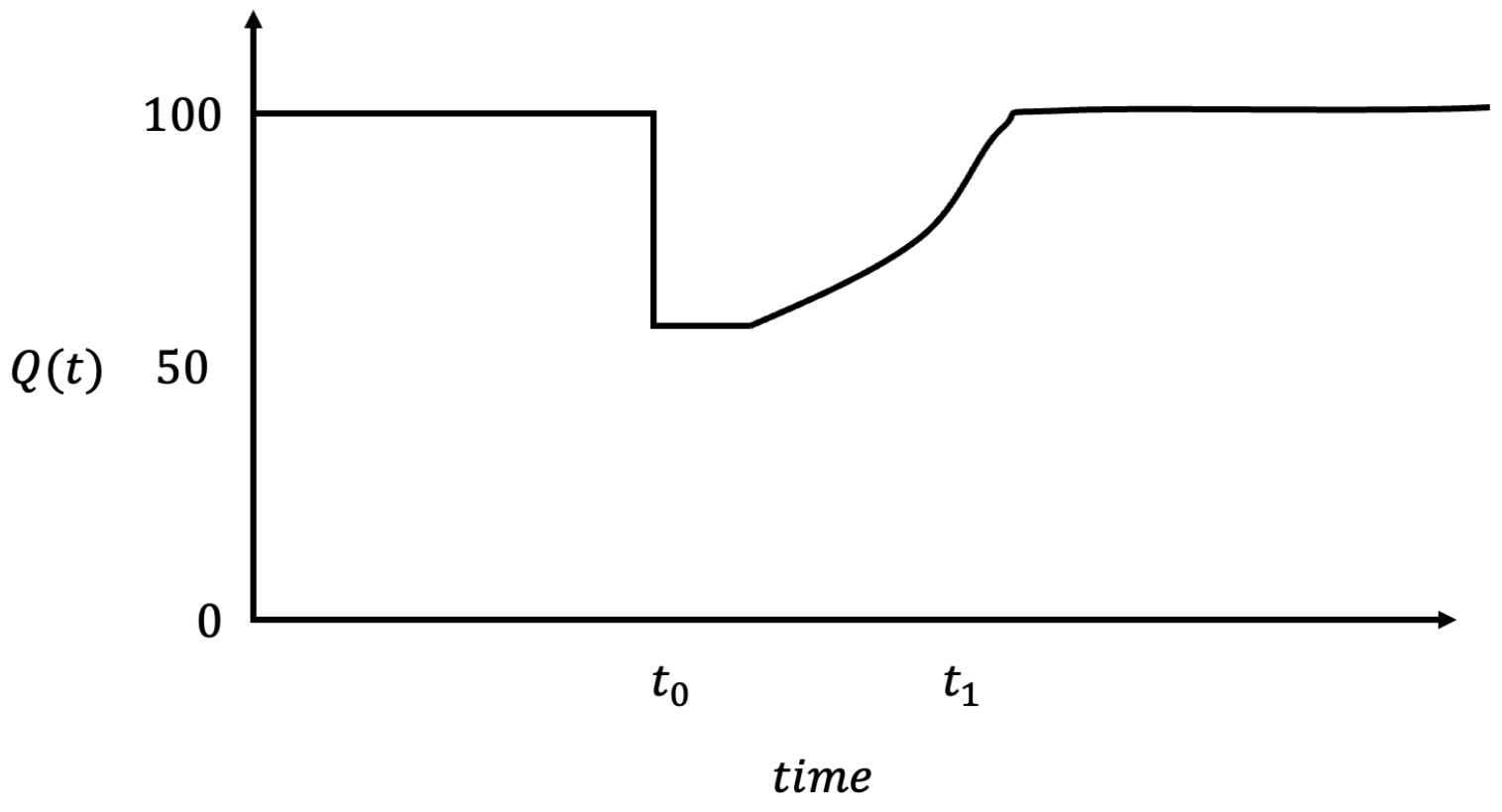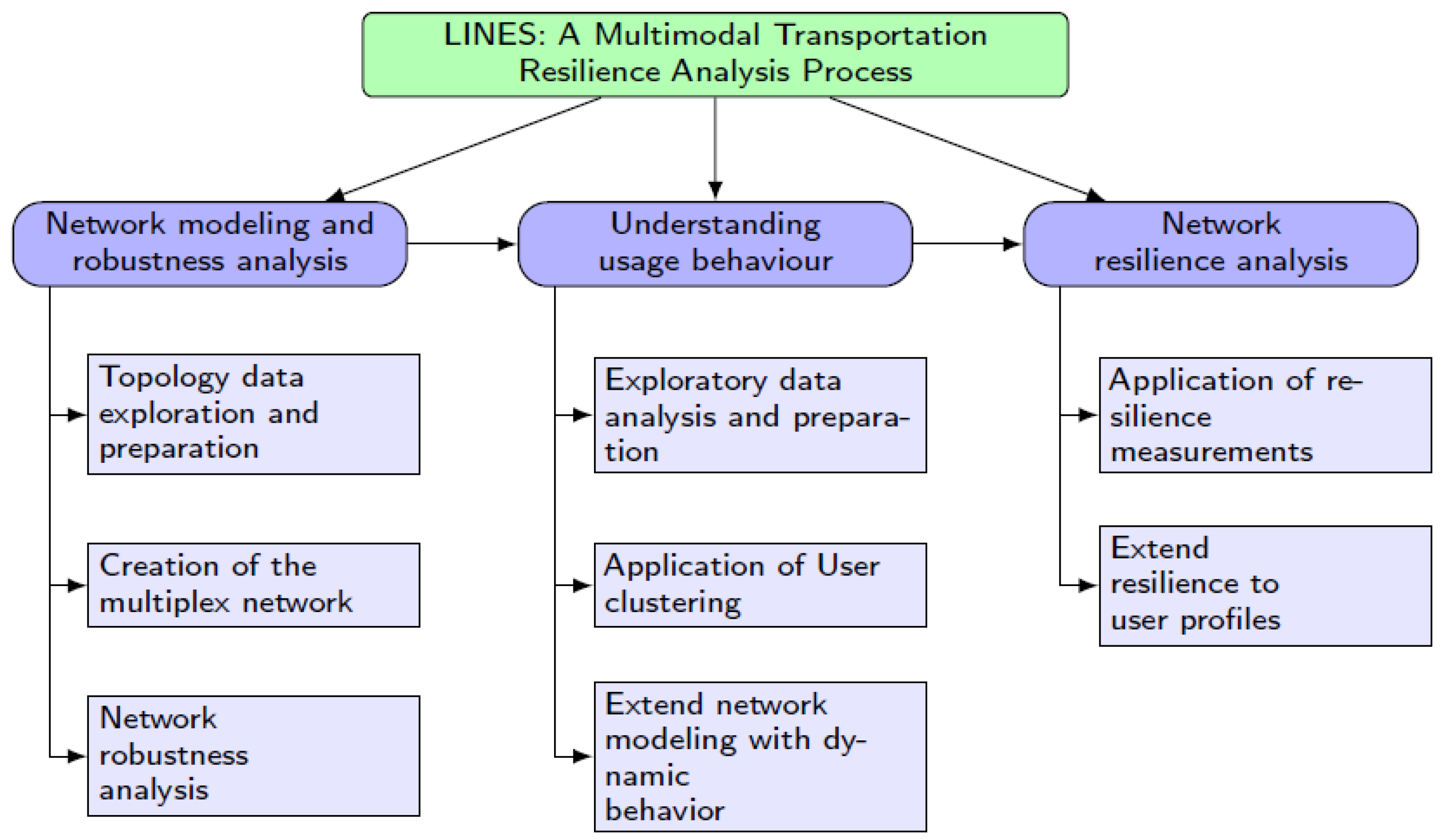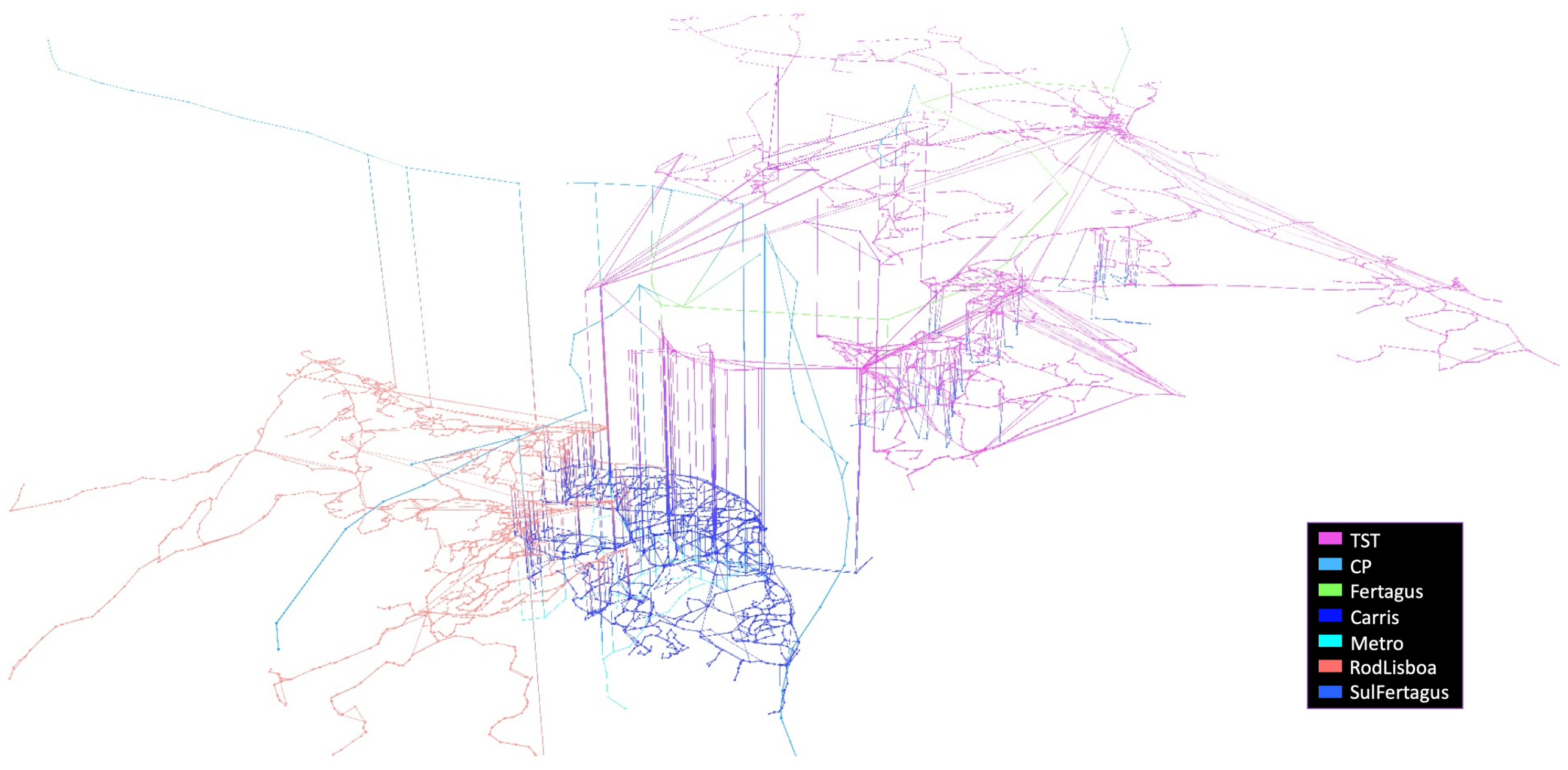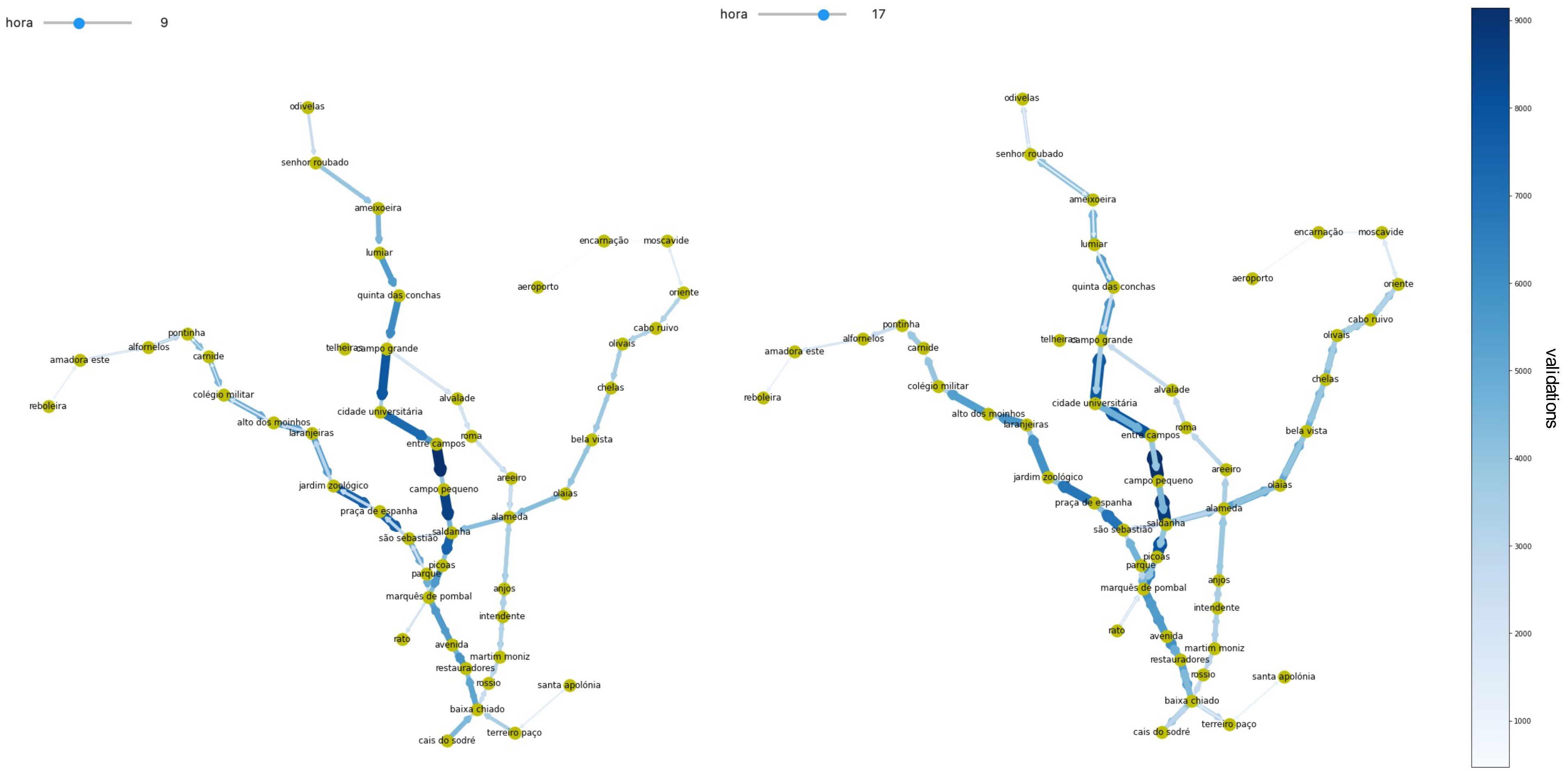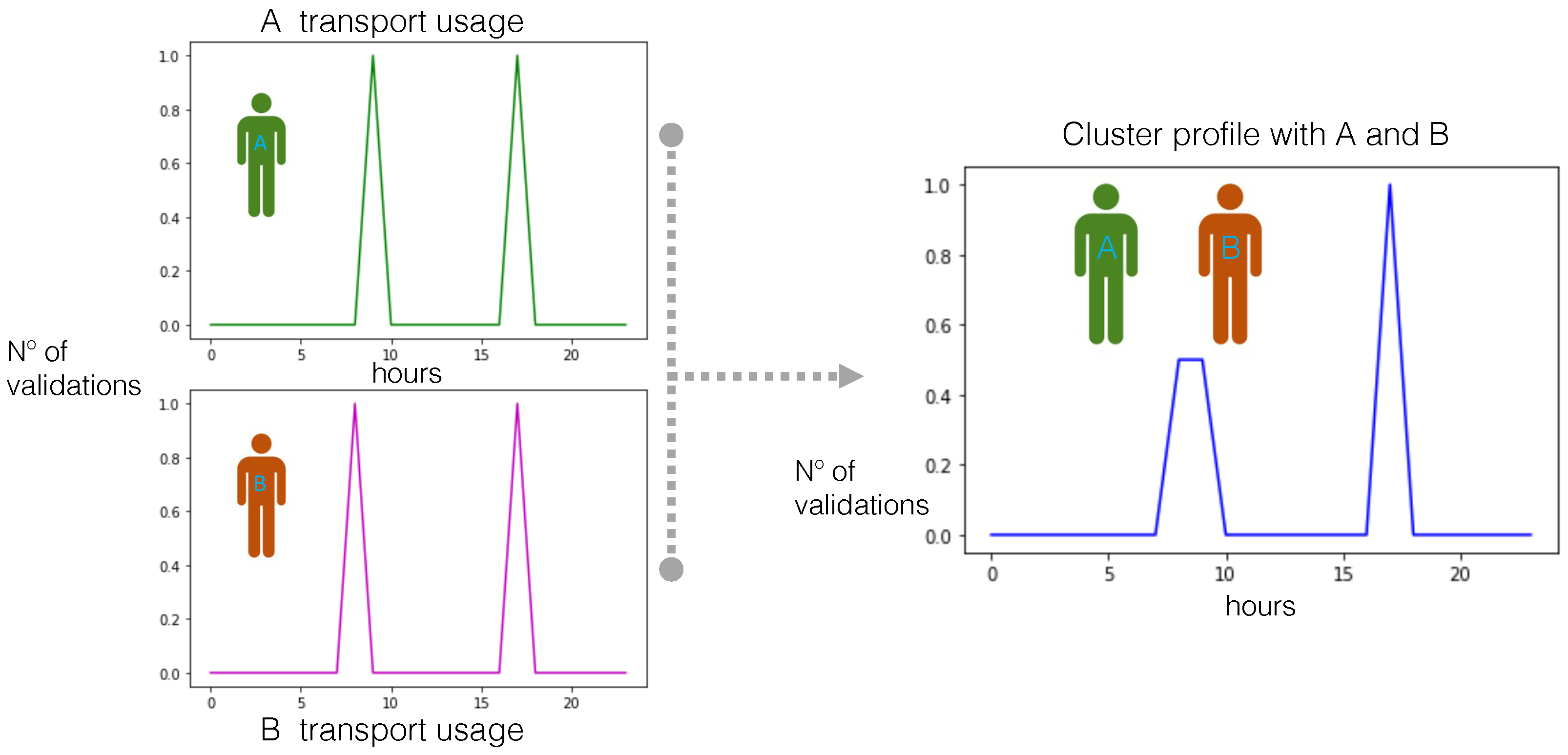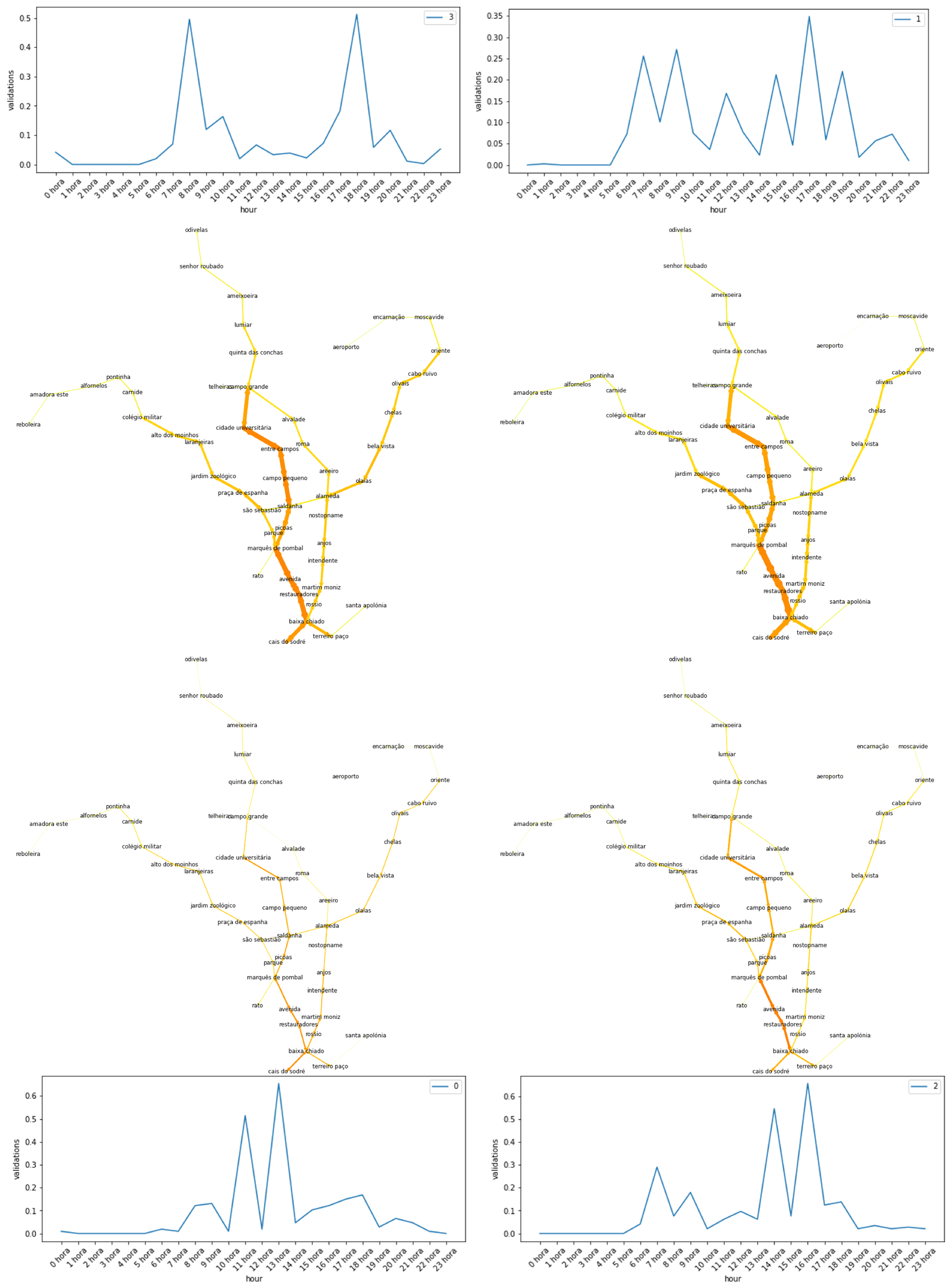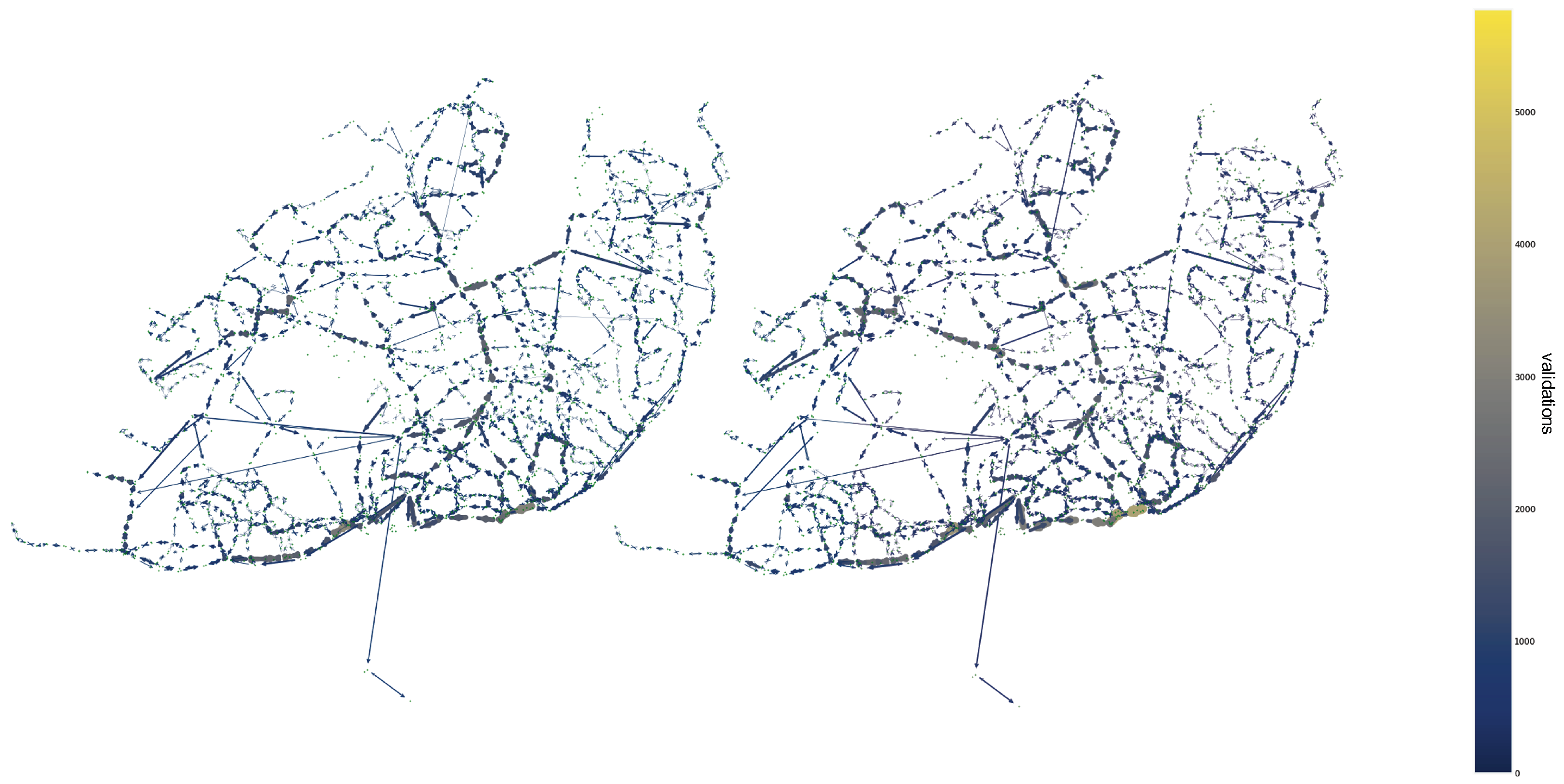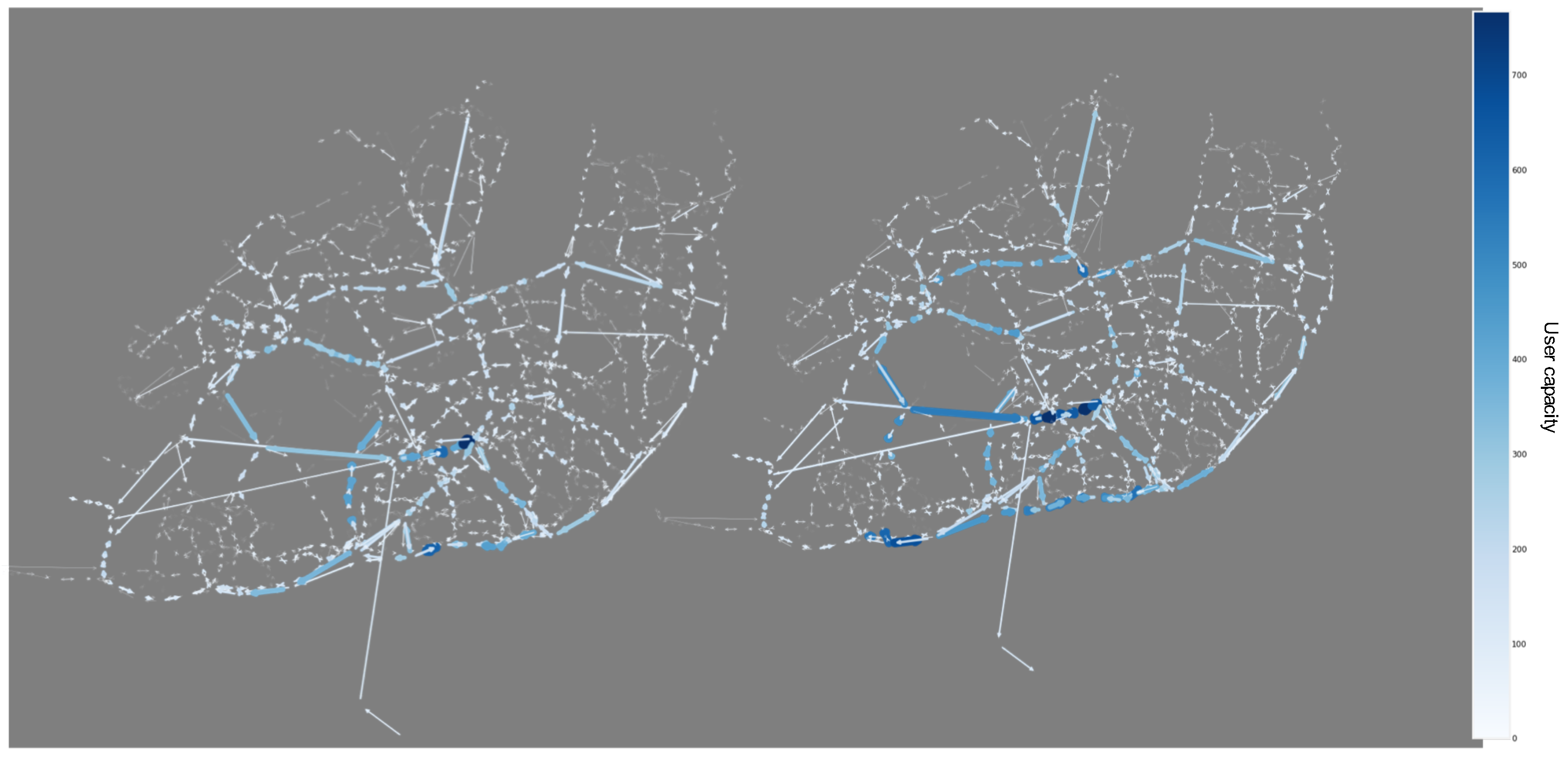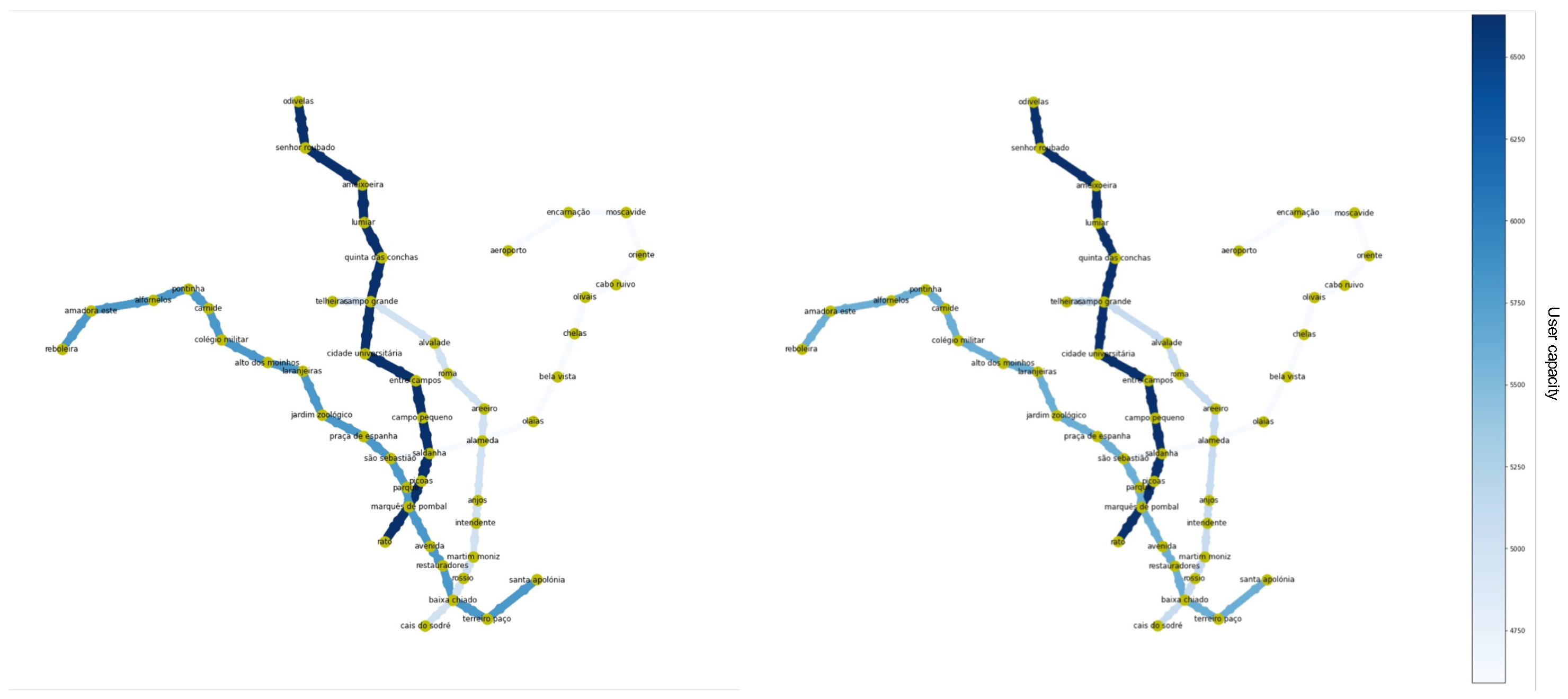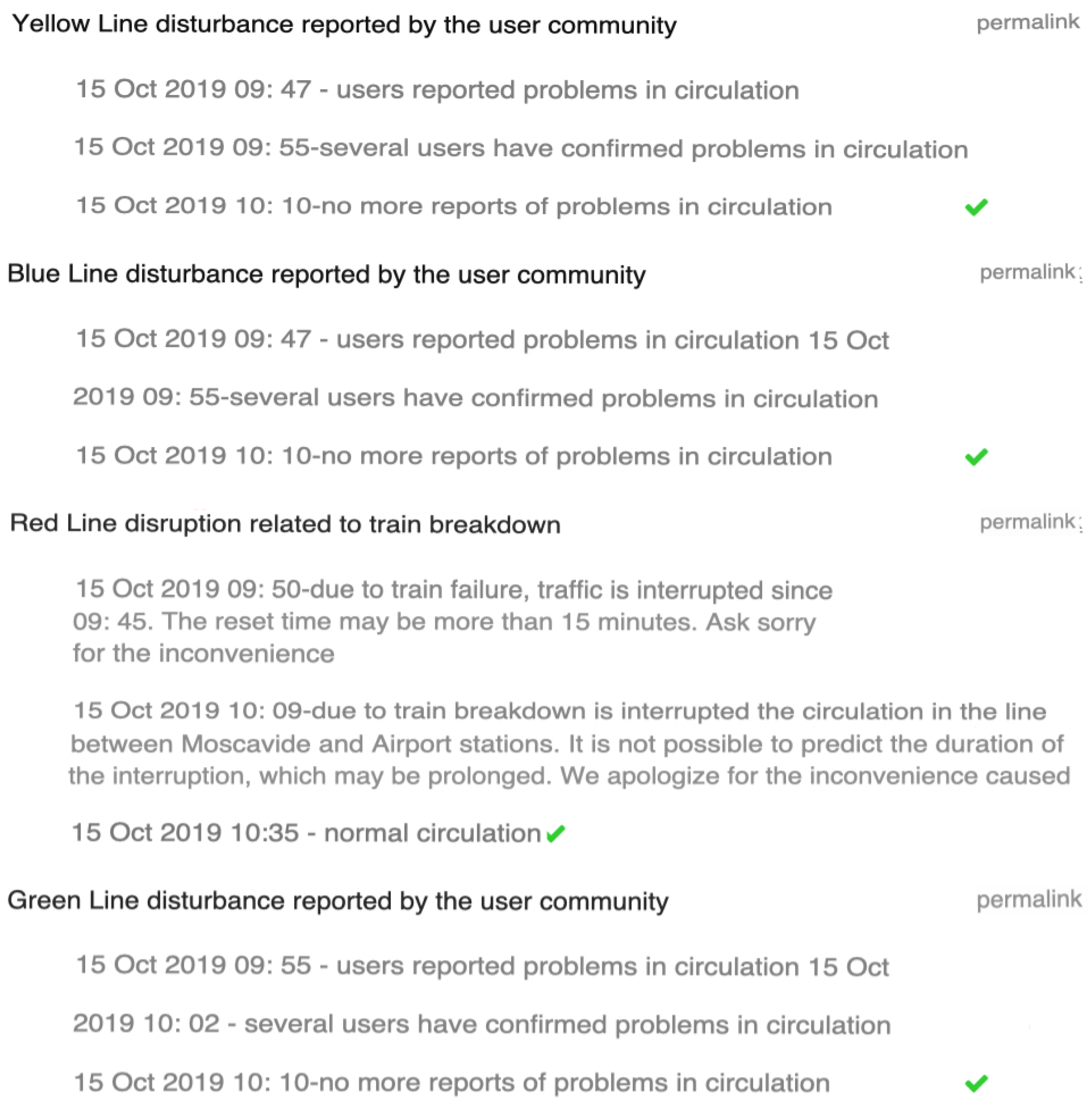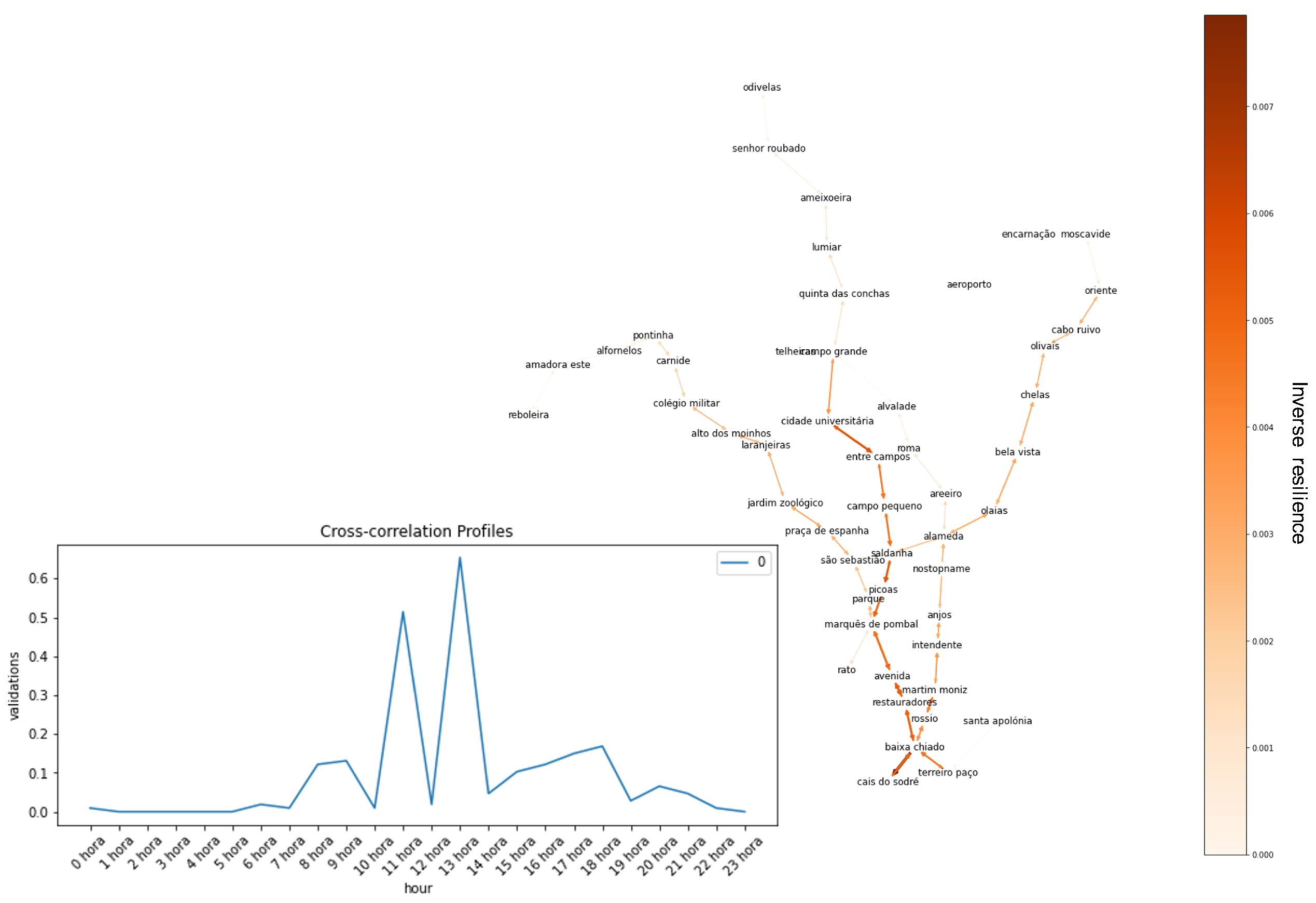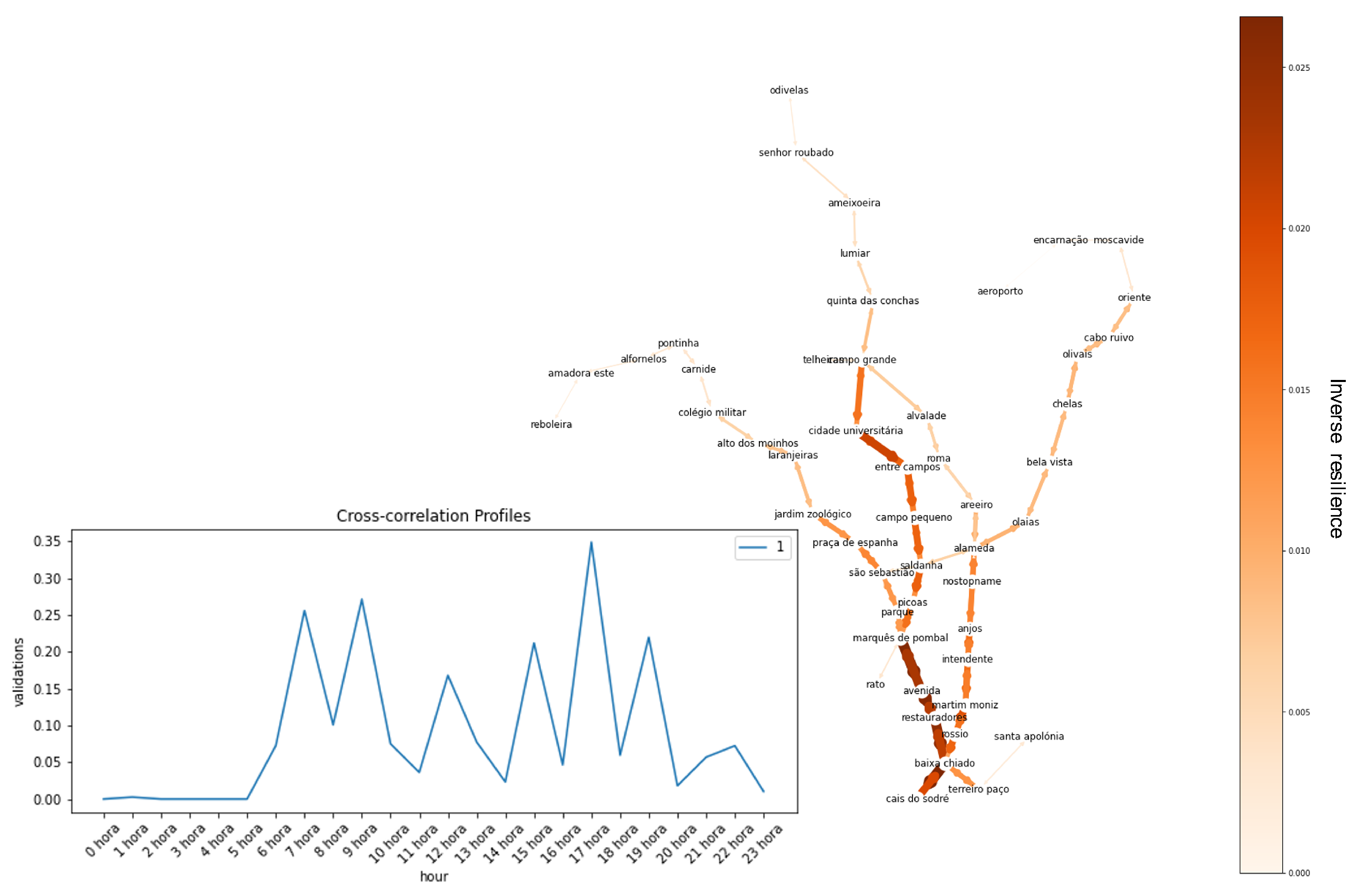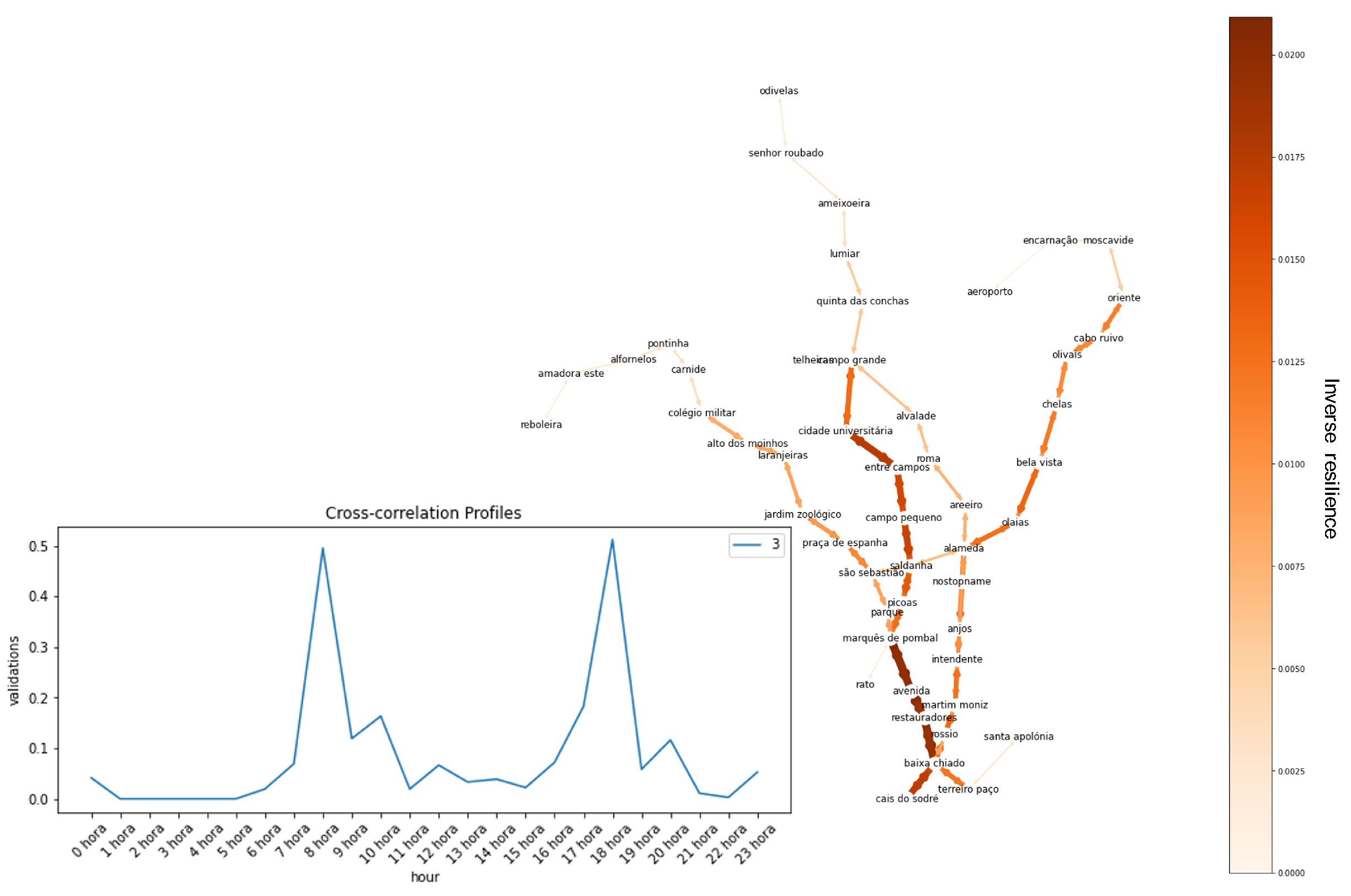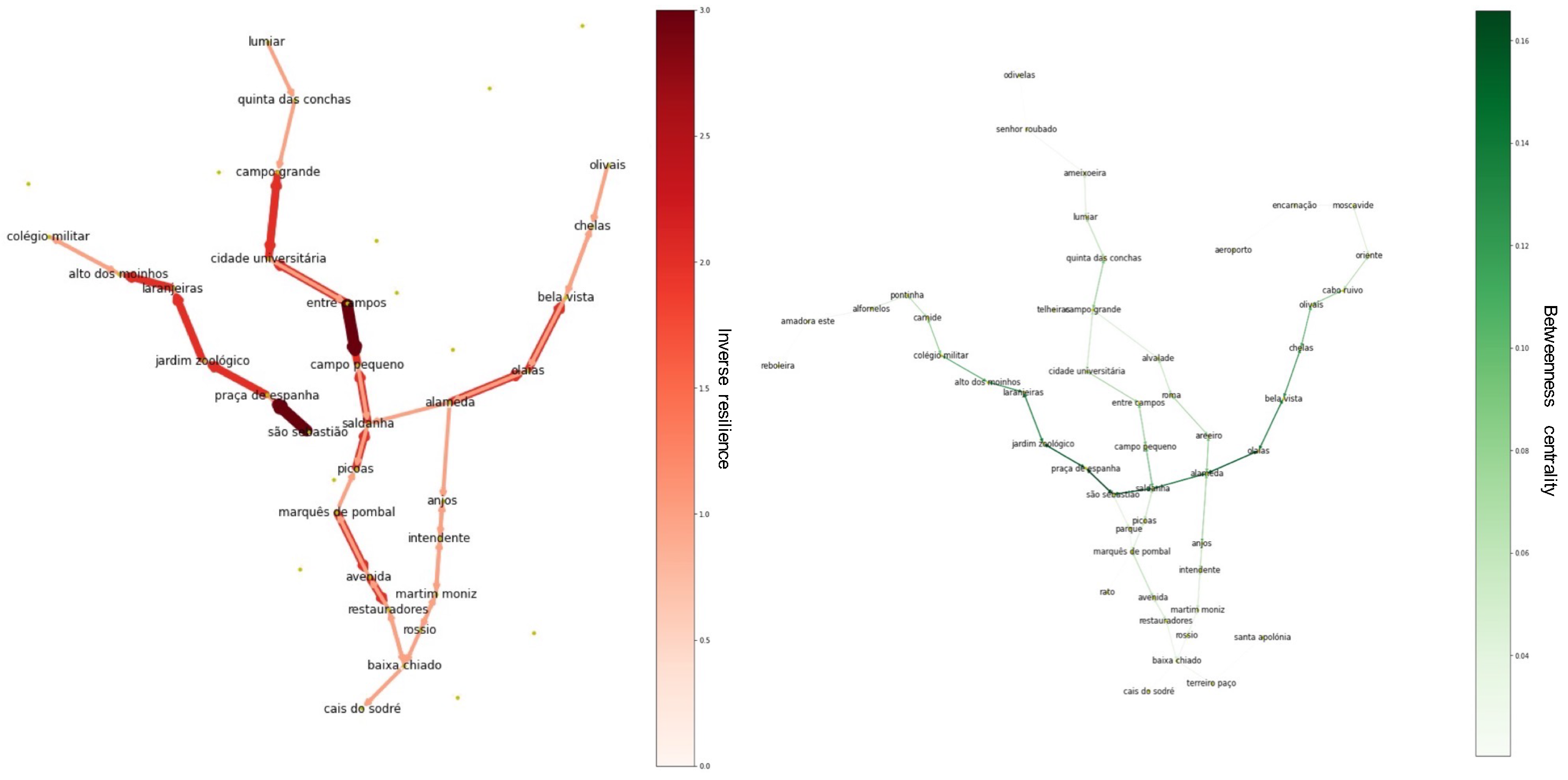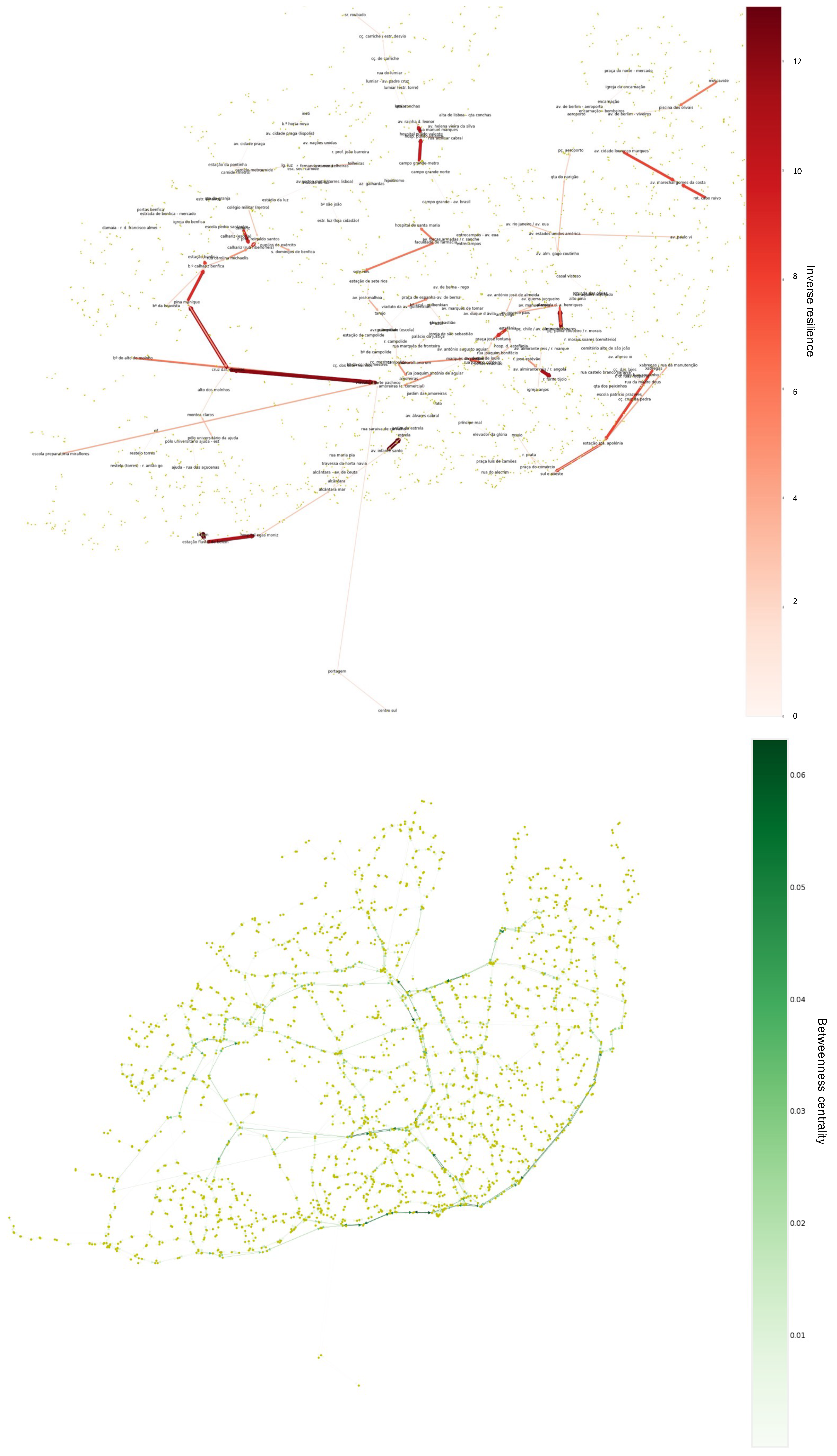1. Introduction
The need for effective and transparent coordination between different transport modes as a means to reduce congestion and failures in different streams has been increasingly seen as a necessary and effective answer to ongoing mobility changes [
1]. To further understand the usage of multimodal transport, the inclusion of resilience assessment models offers a crucial perspective to improving our public services. This requires a quantitative assessment of robustness [
2]. Resilience in this setting measures how the system recovers from fluctuations in transportation demand. However, there is a need to go beyond a monomodal robustness assessment. Thus, here, we focus on a method to assess the resilience of a transportation network with different modalities. In other words, we aim to address how to measure the resilience of a multimodal transport network covering several transport modes. This research aims to propose a method to assess the resilience of a multimodal transportation network. After an initial assessment of multimodal topological resilience [
3], we move to a more dynamic view of traffic vulnerabilities. To this end, we propose the usage of spatio-temporal data statistics to understand the passenger traffic flows within a complex multimodal transportation network. The search for patterns aims to improve the management of different transportation modalities by providing non-trivial usage patterns to the knowledge base of the public transportation’s information system.
In this context, we focus on lean resilience [
4,
5]; this is defined as an agile, data-driven approach to actively reconfigure a system as a means to manage resilience continually. The concept of lean resilience is focused on integrating the resilience measurement process into a continuous paradigm of decision making, instead of a measurement based on sporadic events. This is an emerging trend of research since the COVID-19 and post-COVID-19 changes are felt abruptly in the world of transportation [
6]. This concept has been previously introduced in the context of supply chain management. However, here, we apply
lean resilience for the first time in the context of public transportation and define it analytically. Hence, based on previous literature—Rad et al. [
6]—we define public transportation lean resilience as a measurement of resilience integrating passenger flow and transportation supply with continuous adaptability. This research operationalizes this conceptual construct with the proposed muLtImodal traNsportation rEsilience aSsessment (LINES) methodological process. The acronym reveals the primary focus of the proposal: measuring resilience on line segments of network models. Using the city of Lisbon as a study case, we illustrate the relevance of the proposed methodology to detect actionable vulnerabilities in the bus–tram–subway network.
This document is divided into five sections. After introducing the research context, state-of-the-art contributions on the subject are described in
Section 2.
Section 3 details the proposal of the method for resilience measurement.
Section 4 instantiates the proposed method in the city of Lisbon.
Section 5 synthesizes the main contributions, implications, and possible follow-up research directions.
2. Background
The concept of multimodality is central to this research, commonly defined as “the use of more than one transport mode to complete a trip” [
7], the undertaken stance in this work. The concept of
crossmodality can also be used as synonymous with multimodality.
According to Buehler and Hamre [
8], multimodality is a sub-field of the intrapersonal variability of travel behavior, characterized by four dimensions: modal, purpose, spatial, and temporal nature.
Sustainable urban mobility planning is a central policy concept and methodological approach in Europe [
9,
10] with an impact on several UN Sustainable Development Goals. The primary objective is to increase sustainable urban accessibility and deliver high-quality, long-term mobility and transportation to, through, and within cities [
11]. This is achieved by understanding and measuring system imbalances to avoid energy wasting and promoting more equitable transportation for all. The more interconnected and diversified the sustainable mobility alternatives are, the more efficient and resilient the transportation system as a whole can be [
12].
Transport resilience is classically defined according to four main dimensions: robustness, redundancy, resourcefulness, and rapidity, all with significant effects on fewer repercussions, reliability, and a quicker recuperation [
13]. The way that these dimensions are understood and measured has been a fairly active research theme. Multilayer networks offer a convenient abstraction to describe interconnected communication systems, such as multimodal transport infrastructures. This representation allows for a description of many interconnected communication systems, such as multimodal transport infrastructures. In this case, a node represents a stop or a station, and an edge represents a path between them. In this context, we may start by looking at key topological features, such as centrality [
14,
15] and connectivity [
2], all suitable measures to characterize robustness and how the network can be affected by perturbations. From a dynamic perspective, using edge weights to represent passenger flow, the throughput, travel time [
16], and weighted networks [
17] that result from these measurements may also characterize resilience in terms of functionality. Additionally, there is a stance firstly introduced by Bruneau et al. [
18] where resilience is characterized by a curve based on the time to recover from an initial degradation event.
Figure 1 shows an example of a curve (from the original study) that characterizes resilience by measuring the size of the degradation in terms of the infrastructure impact.
This stance originated the resilience triangle and the resilience index, later formalized by Reed et al. [
19]. The resilience index in the context of a networked infrastructure can be calculated as
where
is the system functionality between
and
. This index offers a generalization of the concept of resilience.
To understand the topological features that characterize the network and potentiate particular flow patterns, we look at assortativity and betweenness centrality. Assortativity means the attachment preference of the nodes in a network to other similar nodes. Similarity it can broadly refer to a specific set of characteristics referring to degree similarity; this property is commonly termed degree–degree correlation. Assortative mixing,
was mathematically defined by Piraveenan et al. [
20], where
is the standard deviation of the degree distribution,
is the joint probability distribution of the remaining degrees of two nodes,
k is the degree of a node, and
is the relationship between the degree distribution
and the link distribution
.
In this case, assortative behavior would correspond to stations with high degrees linked with other stations with high degrees, and disassortative would correspond to stations with high degrees linked with others with low degrees. Assortative behavior may lead to a high user flow in intermodal interchanges; for instance, since central stations may be only connected to one another.
Another important concept is betweenness centrality proposed by Linton Freeman [
21],
which measures how important a node is in connecting communities of nodes.
V is the set of nodes in the network,
is the number of shortest paths in a network, and
is the fraction that flows through the node
v. A high betweenness centrality means that that node is an important bridge between communities, and, literally, it means the percentage of shortest paths in the network flow through that node. A high value for edge betweenness centrality may be a good indicator that the traveler flow will be high in that particular line segment.
To answer the need for measuring the resilience of networks, Klau and Weiskircher [
22] noted that a network should be considered resilient if it sustains a high number of node failures before it turns disconnected. In that sense, performing node percolation tests is a way to measure resilience. Measuring this property in transport networks has been the focus of several studies. Sulivan et al. [
23] have evaluated system-wide robustness by finding critical isolating links in road networks. They reduced the link capacity and measured the travel time as a means of measuring robustness. This allowed for a dynamic perspective as well. Later on, Zhou et al. [
24] developed a similar study but induced vulnerabilities by blocking lanes instead, same as deleting an edge, which ranked the links by how critical they were, building upon the much earlier work that did just that [
25].
The previously mentioned studies were highly related to the earlier study of reliability performed by Chen et al. [
26], where the demand change gives the reliability of networks based on models of the route choice. This study extended the capacity reliability to network equilibrium models, as well as taking into account the route choice actions of drivers. Later on, Al-Deek and Eman [
27] measured the reliability by the network capacity and travel time by changing the demand and inducing link degradation and non-persistent congestion. Previous studies are, in fact, critical because they showed how different demand levels affect the capacity reliability in an analytical way. It is important to note that reliability is fundamentally different from resilience. Reliability usually measures the interruption of service. Resilience, on the other hand, measures the ability to recover from such an interruption in service [
28]. The importance of the study of system resilience increases due to the limited ways that systems are either successful or failed in a binary view of reliability and system efficiency.
A study of network resilience has also been conducted in the context of multimodal transport. Montes-Orozco [
29] recently showed that the same idea of percolation could be used in multiplex networks. This notion opens this test for the world of multimodal transport network resilience.
Another view on resilience measurement on multimodal transport networks is given by Bocewicz [
30], who postulates that a whirlpool network structure on a multimodal transport network leads to a cyclic steady state, unlike a tree structure. A whirlpool state is one that points towards another, and the following states recursively point to the following until they complete a circle. Then, the measurement of robustness is given by the ratio of states in a whirlpool structure and the total number of states in the multimodal transport network.
Besides a simpler network structure resilience test, a dynamic measurement of such a property has also been studied in multimodal urban transport. Stamos et al. [
31] studied resilience to extreme weather events (EWE) in several European cities by measuring the percentage change during the EWE. Then, this could be used for prediction tasks by using past rail, air, and road usage data. However, this method was lacking in terms of actionable information because prevention is only attainable if we know where to act. Later on, Cats et al. [
32] defined a framework to assess robustness. This helped the description of robustness assessment as an economic problem. This kind of assessment is very relevant for this study because it provides a baseline for understanding the impact of different disruption scenarios in specific links, quantifying the criticality. This is a type of assessment that provides specific enough data to be actionable in the real world.
Recently, Chen et al. [
33] proposed new strategies to optimize a transport network structure, considering not only the cascade impacts of disturbances but also the simulated ability to repair from those disturbances. The accessibility and percentage of unaffected passengers are guiding criteria for the resilience assessment in this study. This research was followed with an effective betweenness centrality metric [
34] able to disruptively incorporate the traveler’s path choice and travel time into the resilience assessment. In contrast with our work, capacity shortages are not considered, with the focus being placed on establishing time-invariable measurements of the criticality of the components of a transport network.
4. Results
Following the modeling of Lisbon’s multimodal transportation network in the previous research [
3], this next section focuses on applying the dynamic information on the networks. Below is the representation of the modeled network, including several transport modalities (
Figure 3).
4.1. Extend Network Modeling with Dynamic Behaviour
This section explores the dynamics of the modeled network (
Figure 3) using smart card data described in the previous section. Based on the origin–destination (OD) mapping developed by Cerqueira et al. [
40], we mapped the origin and destination of each user and find the geographical shortest path within the pre-existing lines from one station or stop to another. Using this method, we weighted
METRO and
CARRIS networks with the number of users that go through each pathway (edge in the graph) at every hour of the day.
In
Figure 4, we see the user demand in two of the 24 time-spans of the day, at 9 A.M. and 5 P.M. on a typical Tuesday. The generated weighted digraphs show a heavy flow of users towards the city center at 9 A.M. A high flow of users are going towards stations such as Marquês de Pombal, Picoas, Saldana, and São Sebastião. There is an apparent cumulative effect that happens within the line that causes congestion within some regions of the network, such as from Campo Grande to Picoas. On the extremities of the network, we see a much lower flux of users. In some cases, we see a relatively balanced number of users flowing both ways, such as the Alameda–Martim Moniz pathway and the Oriente–Chelas pathway. On the 5 P.M. weighted graph, we see the inverse pattern. Users are traveling outwards from the city center, and many of them are traveling from stations outlined before.
This principled analysis may be extended with the average or median values along certain periods, such as a month. In this work, we show the flow of users in a single day, so we can later understand how the network is able to handle the users on a particular day. This is important since not all days have the same service levels, and the variation may have a high impact on the information that we perceive.
Following the different user mobility profiles devised in previous research [
4], we can then associate these profiles with the network data. The method used to generate these clusters considers the number of user-specific card validations every hour, turning user profiles into time-series. Then, we applied a cross correlation distance with an agglomerative hierarchical clustering method and, in accordance with silhouette analysis, selected four predominant clusters. In
Figure 5, we see the example of a user profile with two users that use
METRO at similar hours.
Now, looking at the geographic distribution of the users by profile (
Figure 6), we see that the line occupation of these users is considerably similar within this network. This is understandable since only the timestamps associated with smart card validations were considered, not explicitly capturing the spatial extent of the network usage. However, is this profiling more informative for service resilience? This is the focus of the next section.
In terms of
CARRIS usage (
Figure 7), we find a much more complex network with many nuances in terms of passenger traffic flows differences between 9 A.M. and 5 P.M. At a higher-level analysis, we can see that the southern riverfront lines have the highest flows, and the magnitude of variation in user occupation is much higher in this mode, even though the total occupation per pathway is much lower. This is perceivable since
METRO carriages can hold more people than
CARRIS buses.
In this section, we have extended the classical resilience stances to incorporate the dynamic passenger behavior and its spatial distribution along with the network structure. With the generated data, we were able to better understand the passenger traffic flows on the network throughout the day. In this section, we aim to measure the resilience of a multimodal transportation system. Nevertheless, to measure the network’s resilience to demand changes, we need to measure the dynamics of the network transportation supply. Thus, we might ask if the supply for transportation is keeping up with the demand and what consequences the lack of equilibrium entails.
4.2. Application of Resilience Measurements
Having the schedule, we used the
CARRIS official website for information regarding the fleet that is being used. The calculations were made based on the standard MAN 18.310 HOCL-NL bus since we had no further information regarding the bus type distribution. This is the most common bus type and is about the average capacity, with a maximum occupancy of 76 passengers. The highest possible occupancy is 155 passengers on the articulated kind and the lowest is 27 on the minibusses. Nevertheless, the occupancy numbers may greatly vary depending on safety measures imposed by COVID-19 restrictions. In this case, we used the schedule values for 2019 since the 2020 occupancy values are not representative of a typical year due to the lockdown and the civil emergency state [
41].
Figure 8 depicts the
CARRIS network, and the weighted edges represent the paths that each route has to go through. This was inferred based on the stop times, which allow us to know the progression of stops for each specific route (including the temporary buses). Since the nature of these data is spatio-temporal, we used two distinct hourly time-spans: 9 A.M. and 5 P.M.
Complementary to the attained demand views, the weighted graph regarding the supply levels was calculated using the schedule with hourly granularity. Routes were calculated based on the succession of stations of each passage. Moreover, the weight of the segments of the graph that belong to the route was incremented with the vehicle capacity. This process was performed iteratively through the complete schedule. The representation of the weighted graph uses hue and line thickness, according to the segment’s weight, to accentuate the value and priority level of the segments.
Now, looking at the supply levels for
CARRIS (
Figure 8), we see higher supply levels for 5 P.M. than for 9 A.M. Most of the pathways support 100 passengers or less (per hour), possibly due to traffic constraints. However, these segments may be more susceptible to variations in demand. The planning seems to be congruent with the demand in many cases. For instance, the city center’s inward flow from Ponte 25 de Abril is prioritized in the morning and the outward flow in the afternoon.
Figure 9 shows resilience levels that are between 0 and 2 in most line segments. However, the demand is eight times higher than the supply in certain segments. We can see examples of this undesirable imbalance between the stations Marquês de Pombal and Av. Duque de Loulé, as well as Pina Manique and Cruz das Oliveiras. This may be due to a low tolerance to variance driven by a low bus frequency. However, the model assumes the provision of standard buses, and these segments may nevertheless be supplied with high-capacity buses.
We applied an analogous technique to the
METRO network; however, we used the average carriage values that have much less variance. A carriage has, on average, approximately a maximum occupancy of 170 passengers, using the official
METRO website data [
42]. We also assumed a length of three carriages, totaling a 510 maximum occupancy. These assumptions were made since we were unable to obtain more detailed data.
The
METRO supply levels seem identical at both periods (9 A.M. and 5 P.M.), see
Figure 10. This may be adequate if the transport demand and user needs are similar at those hours. However, as we have seen, that is not the case, so this may be an indication of low resilience in the afternoon. The red line, Aeroporto to São Sebastião, also seems to have an exceptionally low level of service.
The day of October 15 was selected as the day for this analysis due to the fact that it has perturbations reported by the metro users in
all lines at 9 A.M., along with a train breakdown. Below,
Figure 11 shows the reports from
https://perturbacoes.pt [
43]. This is important since it can give us a better understanding of where the failures may impact the transport users. In this context, this is adequate since we want to measure the resilience towards demand change. The metro system works with disturbances and we want to measure the ways in which it deals with the cumulative effect of demand from travelers from several hours.
For the
METRO lean resilience,
Figure 12 discloses the ratio of user demand per service supply. Thus, the value of 1 means that the system has reached its full capacity in that particular network line segment. The left plot for 9 A.M. shows us that the service inwards to the city center is being overcrowded in particular segments, such as Entrecampos–Picoas and Jardim Zoologico–São Sebastião. Interestingly, the red line (Aeroporto to São Sebastião) has a high occupancy between Cabo Ruivo and Saldanha. However, the flow of users is fairly low on this line, which may be explained by the perturbation and the lowest level of service in the METRO. The 9 P.M. service levels, on the other hand, have even higher vulnerability levels than in the morning. Nevertheless, there are no reported incidents for this hour and day. This means that even with incidents in the morning in all lines, the afternoon demand–supply equilibrium is worse in the afternoon regular operation. This means that the levels of service need to be reinforced even in normal conditions. There is a clear pattern of outwards mobility from the city center with high congestion in the same zones and, yet again, an aggravated effect on the red line from Saldanha to Oriente. Even though the information in this document is static, we can easily transpose this to a real-time monitoring system that shows the over-demanded segments thorough the day, outputting a representation similar to the left graph on
Figure 12, which highlights the low resilience links. This would bring further actionable information.
4.3. Extending Resilience to User Profiles
Previously, we motivated the relevance of clustering passengers into different behaviors. The mobility profiles have different impacts on the network depending on the hours when each user uses the network and where they are. This means that even if there are few users of a particular type, the network may be less resilient to that particular demand. Below, we look at the different profiles and the lean resilience for each cluster of users. To produce these representations, we calculated the paths of users per cluster (based on the shortest path considering the pre-existing routes) and weighted the edges of the network based on the accumulated demand–supply ratio over an hourly basis. To understand the resilience towards a certain user (a user-centered resilience) behavior type, we used the sub-samples obtained from the clustering solution and weighted the edges based on the ratio of demand for the supply levels of a particular hour.
Figure 12 shows the
lean resilience of all users at two particular timestamps, whereas
Figure 13,
Figure 14,
Figure 15 and
Figure 16 show the resilience of each particular user profile at 9 A.M.. This leads to significant differences due to the cumulative effect of users and the absence of normalization per visualization.
The usage profile from cluster 0 is interpreted as “lunchtime commuters”. These exert more pressure on the system in the city center, particularly from Saldanha to Cais do Sodré and between Entrecampos and Cidade Universitária.
The usage profile from cluster 1, capturing long workday commuters, exerts higher overall stress levels on the system than user profile 0, for example. However, this is expected since the cardinality of users is considerably different. There is a lot of stress from Marquês de Pombal to Cais do Sodré and moderate levels in the pathways: Jardim Zoológico–Marquês de Pombal, Baixa Chiado–Alameda, and Alameda Oriente.
Cluster 2, previously understood as part-time workday commuters with shifted intervals, has strains along the Marquês de Pombal–Baixa Chiado pathway and generates medium strain levels from the city center to Laranjeiras, Campo Grande, and Oriente.
Lastly, users belonging to cluster 3 have a considerable presence in all lines, particularly from Campo Grande to Terreiro do Paço, with noticeable presence in Olivais to Alameda, Collegio Militar to São Sebastião, and Alameda to Cais do Sodré.
It is clear that, at this moment, there could be some incentives to alleviate the strain on transport by increasing the level of transport by the number of the demand–supply ratio achieved from this analysis. This could be achieved by vehicles with a higher capacity, higher frequency, or even a mixture of both. Another solution could be incentivizing the flow of users towards off-peak hours. This latter strategy can be achieved by implementing a gamification system that assigns usable points for good behavior, like in other smart city gamification systems [
44]. This could also be integratively solved with the aid of alternative modes of transportation. It is important to note that, if incentives for adopting other transport modes are the desired solution, the strain of the target modes must be considered. Using a multimodal approach to transportation, we could induce transport users to shift to less-used modes by assigning points as incentives to change modal preferences that could be used for monthly fare discounts, for instance. The use of past and current data could be used to generate agent-based systems to decide under those circumstances [
45]. The study of these incentives and the implementation of similar techniques to the ones used in this research yield interesting opportunities. These studies could answer questions such as: What incentives may be qualified as worthy? Can we model commuters based on data-driven behavior? Did the mobility profiles change after the application of incentives? Did the pathways become less strained after incentives?
To understand the fragility of the
METRO and
CARRIS networks, we rely on two perspectives: (1) a dynamic perspective, by identifying the low resilience links, and (2) a static perspective, the critical nodes (in case of layers). When comparing them side by side (in
Figure 17 and
Figure 18), on the left, we see the number of times each segment exceeded capacity throughout the day (these are regarded as low resilience since they were not resilient to user demand), and, on the right, we see the betweenness centrality of each edge.
We see that the betweenness centrality is important to understand the robustness impact. Nevertheless, without a data-driven perspective, this metric is insufficient to discern usage patterns. Although most of the pathways that exceeded the user capacity do not have a particularly high betweenness, there seems to be a positive relationship in the southwest part of the city in
CARRIS (
Figure 18). In
METRO (
Figure 17), this relationship is fairly evident in parts of the blue and red lines: São Sebastião to Alto dos Moinhos and Alameda to Boa Vista. Nevertheless, we see that resilience is mainly caused by the dynamic usage features. It emerges not only because of topology and cumulative effects but also because of a lack of equilibrium between the supply and demand in particular time frames (i.e., a low lean resilience). A good example of this is the yellow line (Odivelas to Rato) and the southern part of the blue line (Marquês de Pombal–Baixa Chiado), which have no station with a particularly high betweenness centrality but have a low resilience, according to the usage intensity. Still, it is important to note that edges with a very low betweenness centrality have high levels of lean resilience since they are not subject to the cumulative effect of the demand variation from other parts of the network.
5. Conclusions and Future Works
This study proposed an integrated view of multimodal public transport demand from consolidated smart card data validation to model actionable spatio-temporal mobility patterns.
The notion of transport supply was also introduced and modeled on a weighted network based on the schedule and data of the vehicles used by the two transportation layers. This allowed for a better understanding of the transport service levels during all-day periods. To contribute to the body of work regarding resilience measurements, we introduced the construct of lean resilience in public transportation and defined it analytically. This is distinct to current resilience measurements as it assesses the way levels of service recover from different fluctuations of traveler demand throughout the day. Complementarily to organic fluctuations and those motivated by externalities (e.g., large-scale gatherings), this analysis is of significant relevance to further study the patterns of failure of supply of service.
To assess the resilience of a multimodal transportation system, we applied the lean resilience metric on an hourly basis based on the equilibrium between the demand and supply of service. This allowed us to conclude that the network’s resilience is not only dependent on the topological features, such as the betweenness centrality, but a data-driven approach is also essential to understanding the user behavior.
The strain of different types of users on the network service was analyzed, yielding somewhat different results for each user type. This is important because different mobility patterns are observed along the same network paths with varying service levels throughout the day. It implies that the differentiation of user profiles can be induced to improve the distribution of users during off-peak hours. Gamification techniques are discussed as a possible future driver to motivate the shift of users between different transportation profiles. These techniques are yet to be tested in the city of Lisbon, yet offer a promising research direction to manage traveler flows sustainably. The generated resilience graphs for the city of Lisbon public transport aim to improve the lean resilience of the transport towards demand variation using real-time data. These can reproduce accurate representations regarding the absorbability of users in the system, an essential requirement toward lean resilience. The proposed approach is extensible to other cities and geographical locations since the only requirements are a model of the (multimodal) network together with the vehicle capacity and validation usage data, standard requirements for transport systems that comply with general transit feed specification and rely on automated fare collection (AFC) systems. Some challenges lie in managing massive AFC data, scalability needs, and real-time analytics. Regarding transport resilience measurements, complementary dimensions to lean resilience are expected to be further integrated into future research.
